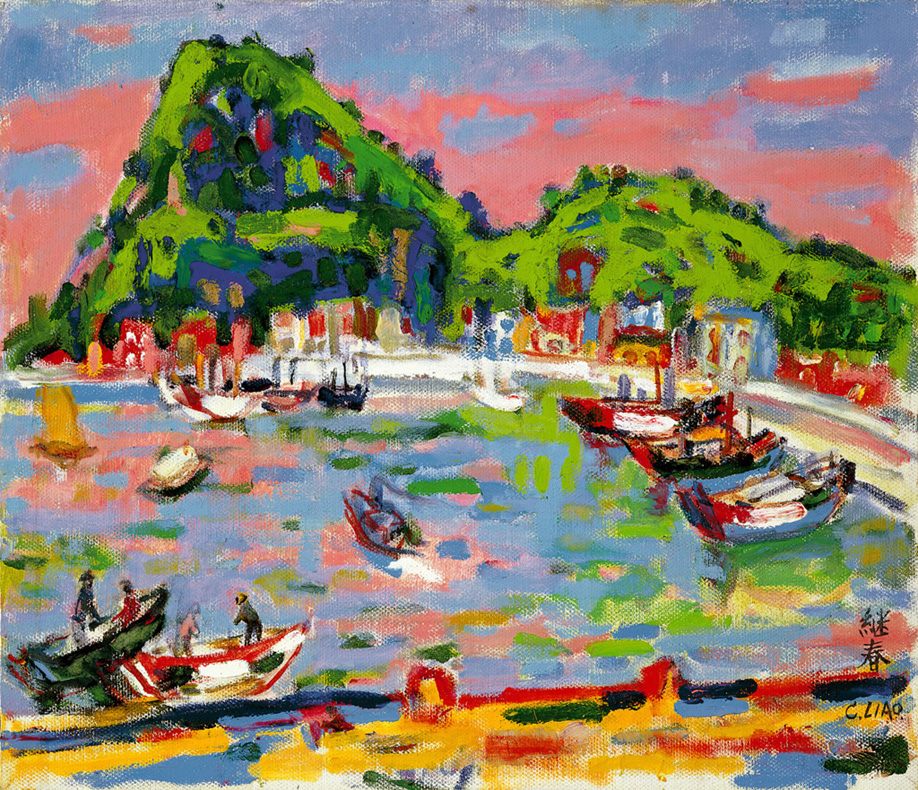What most praised about Liao Chi-chun's paintings is the use of colors; art historiographers praised him as "the magician of colors". The artist said that his colors are deceivable, untrue to the nature. However, it has no difference from overthrowing the "nature is the mentor" tradition of Chinese painters; he took up the aesthetic concepts from Fauvism and Expressionism. He willfully gave the scenery colors from his subjective point of view, and he harmonized, blended those colors together, and shaped the scenery freely at the same time, to achieve a joyful and cheerful feeling.
As for the use of colors and shapes, Liao Chi-chun had his own point of view, he once said: "I use simple, intense colors and the contrast to bring up more colors, in the mean time, I pay attentions to the aesthetic delight between lines when shaping. It is not about my impressions in a specific time; it's simply about representing the colors that I wanted to represent." (Please refer to "The Rainbow Across the Gap Between Generations - Liao Chi-chun's artistic life" by Lin Hsing-yueh, Cathay Art Museum, Taipei, published on March, 1981, pp. 230 - 231)
Critics consider it is due to the stimulation from his visit from Europe and America during the 1960s: "After experiencing the avant-grade trend in the home of the western art, Liao Chi-chun's potentials are fully released. After he returned to Taiwan, he was totally disembarrassed from traditional constraints, and created more boldly. Even in the 1970s, his later years, his works got more colorful, harmony and romance can be easily discovered in variety of colors, when he got older, his paintings got more affecting. He never clung to the shape of the object, through his sensitivity towards colors, and his own unique way to represent the beauty of the world; he has proven himself as an international master of art." (Please refer to "The Magician of Colors: Professor Liao Chi-chun's 100 Year memorial exhibition" catalogue by Kao Hsiu-chu, National Palace Museum, 2001, p. 6)
During the early 1970's, Liao Chi-chun made several paintings of the Yehliu seaside, all of them expressed in a different manner. For an artist, when they return to the same location to paint a landscape, what they face is a whole new challenge. The common characteristics shared by all the Yehliu themed paintings are their emphasis on the view of the mountains, the sea expressed in rich colors as well as the colorful temples, houses and ships.
Taiwan is surrounded by the seas, with the unusual and the spectacular terrain around its Northeast coast always having been renowned internationally for its natural views. The people are also very religious, and temples dedicated to the safety of the fisherman can often be found at in the fishing harbors. The color elements so important to Liao Chi-chun's paintings have their roots in folk art. Among Liao's many oil paintings which have Yehliu as the background "Yehliu Scenery" is to paint the mountains, houses, temples, shores and ships, the colors of the sky and the water are vivid, they are major blue colors, just like to feelings on the chinas from Ming dynasty, red, green and yellow, the color of the Taiwan's temple, can be seen everywhere. The whole picture is like a carnival in a fishing village, filled with the tempo and the passion of Taiwan. The using of the brighter color, pink, is one of the major techniques of the artist; it balanced and harmonized the blue background. Miss Wang Shu-feng addressed: "Pink is no doubt a symbol of mildness and sentiment, it's simply poetry when it showed up among other colors." Critics thinks that pink is Liao Chi-chun's spirit.
The artist's approach to color can be said to be trend setting. By fusing modern elements into the natural landscape, he expresses the youthful energy of a new era. The art historian Wang Hsiu-hsiung once praised Liao Chi-chun's art as "gorgeous and harmonious Fauvism". His brush strokes are unrestrained and simple, with their colors overlaying and emphasizing each other, retaining the sense of freshness and vitality. "Yehliu Scenery" is not a large painting but the great effort made by the artist in creating the composition, the free flowing brush strokes and the rich tapestry of colors combine to create a wondrous landscape that existed within the artist's mind.
Liao Chi-chun loves to paint about landscape, especially the scenery of the river and seaport. During the 1950s he did a lot of sketches in Tamshui. After he returned to Taiwan from the America in the 1960s, the abstract paintings of the America and the civilization in Europe had widened his horizon, and he was greatly affected. During 1960 to 1970, Liao's creations reached the peak. Especially when he saw the scenery of Venice, how boats busily come and go in the river, and the unconfined, harmonic aura of creation, they have transformed to a passion and strength for him, to find his own style. When he's paintings, No matter Tamshui, Ai River, Venice, Yehliu or the last stop in his life, Tong Kang, all of them showed a colorful, lively atmosphere. Including Yehliu, his later works are his essence, after the vicissitudinary in life; his mind surpasses, and returns to innocence. Therefore, the paintings of each scenery and location has went far beyond countries and boundaries, transcended the cultural confrontation, what represented to the viewers are the Shangrila in the heart of the artist. When he is painting Yehliu, he might recall the scenery of Tamshui, or even the canal in Venice, he brings the best of his memories to front. Therefore "Yehliu Scenery" might not be the scenery of Yehliu specifically; it could be the dream land that Liao had been long for.
